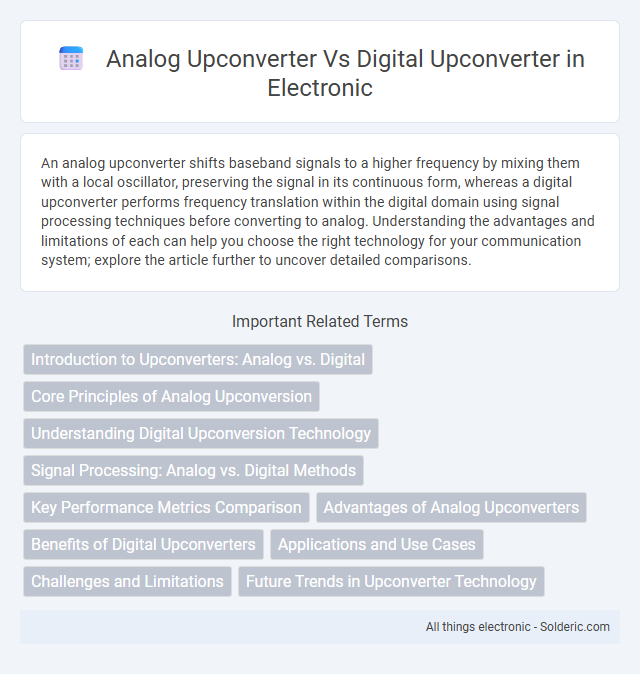An analog upconverter shifts baseband signals to a higher frequency by mixing them with a local oscillator, preserving the signal in its continuous form, whereas a digital upconverter performs frequency translation within the digital domain using signal processing techniques before converting to analog. Understanding the advantages and limitations of each can help you choose the right technology for your communication system; explore the article further to uncover detailed comparisons.
Comparison Table
| Feature | Analog Upconverter | Digital Upconverter (DUC) |
|---|---|---|
| Signal Processing | Performs frequency translation using analog mixers and filters | Uses digital signal processing to shift frequency and interpolate signals |
| Precision | Lower precision due to analog component tolerances | High precision and stability with software-controlled parameters |
| Flexibility | Limited; hardware changes needed for frequency adjustments | Highly flexible; frequency and bandwidth can be changed via software |
| Integration | Standalone analog components | Integrated in DSPs, FPGAs, or ASICs |
| Noise and Distortion | Higher noise and distortion figures | Lower noise; improved signal integrity |
| Latency | Low latency | Higher latency due to processing time |
| Power Consumption | Generally lower | Typically higher due to digital processing |
| Cost | Lower initial cost in simple systems | Higher cost due to complex digital hardware/software |
Introduction to Upconverters: Analog vs. Digital
Analog upconverters convert baseband signals to a higher frequency using continuous-time components, ideal for simpler, low-cost RF systems. Digital upconverters perform frequency translation through digital signal processing, offering precise control, improved signal quality, and easier integration in modern communication systems. Your choice depends on system requirements such as bandwidth, complexity, and flexibility.
Core Principles of Analog Upconversion
Analog upconversion relies on mixing a baseband signal with a continuous wave local oscillator, generating a higher frequency RF signal through nonlinear mixing. This process involves components such as mixers, filters, and amplifiers to shift signal spectra while preserving phase and amplitude characteristics. Core principles emphasize maintaining signal integrity and minimizing noise and distortion during frequency translation in analog domains.
Understanding Digital Upconversion Technology
Digital upconversion technology eliminates many limitations of traditional analog upconverters by converting baseband signals to higher frequencies entirely in the digital domain. This approach enhances signal precision, reduces noise and distortion, and allows for flexible modulation schemes critical in modern communication systems. Your system benefits from improved spectral efficiency and easier integration with software-defined radio applications compared to analog solutions.
Signal Processing: Analog vs. Digital Methods
Analog upconverters process radio frequency signals using continuous-time circuits that directly mix and modulate input signals, often resulting in simpler hardware but susceptible to noise and non-linearities. Digital upconverters utilize discrete-time digital signal processing techniques to perform precise frequency translation, filtering, and interpolation, enabling improved signal fidelity, flexibility, and easier integration with software-defined radio systems. The digital approach allows for advanced algorithms that enhance performance in complex communication environments, whereas analog methods prioritize low latency and simplicity.
Key Performance Metrics Comparison
Analog upconverters typically offer lower latency and better phase noise performance, essential for high-frequency RF applications. Digital upconverters excel in flexibility and signal processing accuracy, providing superior spurious-free dynamic range (SFDR) and easier integration with advanced modulation schemes. Your choice depends on whether you prioritize minimal signal distortion and hardware simplicity or advanced digital filtering and adaptability.
Advantages of Analog Upconverters
Analog upconverters offer superior linearity and lower phase noise compared to their digital counterparts, which enhances signal integrity in high-frequency applications. They consume less power and minimize latency, making them ideal for real-time communication systems. Analog upconverters also provide simpler hardware integration and cost-efficiency for standard frequency translation tasks in RF signal processing.
Benefits of Digital Upconverters
Digital upconverters offer enhanced precision in frequency synthesis, enabling higher signal integrity and reduced spurious emissions compared to analog upconverters. They support flexible, software-defined modulation schemes and allow real-time adjustments, improving overall system adaptability and performance. Furthermore, digital upconverters facilitate seamless integration with digital signal processing frameworks, leading to simplified system design and reduced hardware complexity.
Applications and Use Cases
Analog upconverters excel in applications requiring straightforward frequency translation with minimal latency, such as traditional radio transmitters and radar systems. Digital upconverters find extensive use in software-defined radios, advanced communication systems, and signal processing tasks where flexibility, precision, and integration with digital platforms are crucial. Industries like aerospace, defense, and telecommunications leverage digital upconverters for efficient modulation, spectral shaping, and adaptive signal generation.
Challenges and Limitations
Analog upconverters face challenges such as signal distortion, limited frequency agility, and susceptibility to noise and interference, impacting overall signal integrity. Digital upconverters offer higher flexibility and precision but encounter limitations like increased power consumption, latency due to digital processing, and complexity in implementing high-speed, high-resolution DACs. Your choice between analog and digital upconverters depends on balancing performance requirements with system design constraints and environmental conditions.
Future Trends in Upconverter Technology
Future trends in upconverter technology emphasize the shift from analog upconverters to digital upconverters due to their superior precision, flexibility, and integration with software-defined radio systems. Digital upconverters enable more efficient signal processing with reduced distortion and enhanced scalability for emerging 5G and beyond communication networks. Your choice of upconverter technology will likely impact the adaptability and performance of next-generation wireless infrastructure.
analog upconverter vs digital upconverter Infographic

 solderic.com
solderic.com